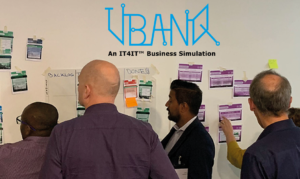 At the Open group conference in Amsterdam, Jan Schilt playing the CEO role of the Banking concern UBanQ challenged a number of teams to prove that they can build IT4IT capabilities to demonstrate that they are the bank of choice for Customers in a highly competitive, rapidly changing digital world. The teams took part in the UbanQ IT4IT business simulation. They are challenged with investing in new products and services and applying IT4IT concepts to reduce costs, increase speed and improve quality with an aim of making the bank the preferred choice of customers.
At the Open group conference in Amsterdam, Jan Schilt playing the CEO role of the Banking concern UBanQ challenged a number of teams to prove that they can build IT4IT capabilities to demonstrate that they are the bank of choice for Customers in a highly competitive, rapidly changing digital world. The teams took part in the UbanQ IT4IT business simulation. They are challenged with investing in new products and services and applying IT4IT concepts to reduce costs, increase speed and improve quality with an aim of making the bank the preferred choice of customers.Three teams each ran a UbanQ branch and each would try to realize the ambitions of the CEO. The CEO declared that he expects a Dashboard showing the performance of each Branch revealing Revenue growth, Cost reduction, Increased margins, Industry leading CSAT, Increased Market share, and increased numbers of customers.
Improvement would be easy if work didn’t get in the way!
As the simulation started the teams were confronted with customer issues, product defects, new customer requirements as well as existing ‘inefficiencies’ causing wasted work as a result of structural problems, supporting redundant products and services as well as technical debt. The teams had to plan and execute the work and at the same time plan and execute improvements, working together as separate plan, build and run units needing to operate as a value chain.
What happened? After the first round the team reflected on what happened and more importantly how does this reflect daily reality. Reflections revealed the following recognized real life issues:
- Difficulty organizing an end-to-end team and flow. Who does what? Who has what information? Who needs what information? How should hand-offs occur?
- Poor communication across the SILO’s (both in terms of team skills in communication and collaborating as well as in terms of accurate, complete, timely, relevant data and information).
- Poor insight into data and information across the different silos. ‘What services are connected to what applications and configuration items. What services should be made redundant. There are mismatches and missing information to support ‘plan, build and run’ needs which causes wasted time, effort, costs and mistakes’.
- Unclear prioritization of work and poor insight into the shared goals and value expectations.
There were no champagne corks popping for the CEO as he presented the dashboards of both teams revealing significant dips in Customer satisfaction, wasted costs and revenue loss.
Building ‘Fit-for-future’capabilities
The IT4IT building blocks were then introduced. The teams could now choose from these building blocks, which ones could help address the challenges or which ones would help reshape the organization to become the preferred digital bank for the customers. The building blocks are ‘improvement ideas’ based upon IT4IT concepts that each SILO in the team can suggest such as ‘integrated databases’, ‘automated testing’, ‘portfolio plans of strategic initiatives’.
Different UBanQ teams often choose different building blocks to start with, architects often choose the CMDB (e-2-e backbone), Business product owners choose for ‘portfolio planning’, DevOps stakeholders may choose for ‘automated deployment’. The question is who is responsible to the end-to-end alignment and dependencies of these building blocks to optimize the value chain?
Theory. Easier said than done!
The teams in the simulations all selected different building blocks and realized that improvement means more than simply installing new tools and processes. Changing behaviors and integrating end-to-end capabilities are crucial. What happened?
- Double ‘Wasted’ work (inconsistent, missing end-to-end CMDB), unused capacity (poor visibility into backlog and work-in-progress).
- Despite investing in an Integrated Database it was not seen as relevant. It was unclear HOW that would benefit people.
- Integrated database installed, but not everybody knew how to use it or integrate it into their working practices.
- Too much SILO’d working, doing your own work without end-to-end goals and priorities that deliver value.
- Nobody was ensuring alignment and integration of building blocks throughout the value chain.
Streams and chains, but where’s the value?
‘….did anybody know the goals and value expectations’? was a general question during the team retrospectives. The CEO shook his head in frustration ‘It is all well and good applying these approaches like IT4IT and using up valuable resources to install these tools and practices but if we do not have a clear goal as to the value to be realized, and ensure that this flows through the end-to-end value chain then it becomes more a chain around my neck slowing down my progress…..’
The teams once again agreed improvements and adopted new building blocks to be applied, ensuring a focus on end-to-end capabilities. Still teams struggled to embed the new improvements into their way of working. Behavior change, coaching, ownership, leadership were all invisible aspects and skills required to make IT4IT work.
Discoveries
‘Revenue was a little higher, CSAT lower’.
What were the key discoveries from the teams relating to the importance of the IT4IT building blocks and approaches to using them successfully within their own organizations? It was clear that this is a long, tough journey of iterative improvements to change mindsets, behaviors and build end-to-end value chain capabilities.
- It is critical to have the end-to-end data and information flows, integrated, consistent and usable (people know how to use it to support and enable e-2-e value stream activities and decision making).
- When work piles up the focus is on new business demands and outages, often too little focus on removing waste, barriers and blockers. Prioritizing resources and reserving time for continual improvement is key.
- Efficiency is not effectiveness, one team had won on efficiency for ‘automating’, however the CSAT scores showed lack of effectiveness. A clear need for continual learning and improving focused on doing the right things.
What the team had experienced matched the core messages in an earlier presentation ‘IT4IT Reference Architecture: Natural fit for DevOps and SAFe’
‘IT4IT started off because of different tool vendors tools not working well together. There was a need to standardize interfaces and data architectures to help tool users to stop wasting money on tool integration’.
‘…What we need is the ‘automation of the flow of data through the tool chain’ to enable a DevOps tool pipeline...’
‘…Flow of information between SILO’s is often unclear and inconsistent…’
It was clear to me that IT4IT, DevOps and the latest ITIL4 all focus on value chains and value streams. DevOps is often interpreted as CI/CD tool pipelines, ITIL4 is often focused primarily and processes and workload management tools. One of the key benefits from IT4IT is that it helps add the end-to-end value chain focus on integrated data and information that supports, underpins and enabled DevOps and ITIL4.
Blog by Paul Wilkinson | GamingWorks BV and Rob Akershoek


![Workplace-Header-2048-x-1032-wit[12] Workplace-Header-2048-x-1032-wit[12]](https://dxcservicenowbusinessgroup.com/hs-fs/hubfs/Workplace-Header-2048-x-1032-wit%5B12%5D.webp?width=1946&height=272&name=Workplace-Header-2048-x-1032-wit%5B12%5D.webp)